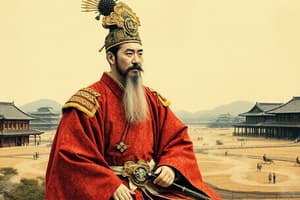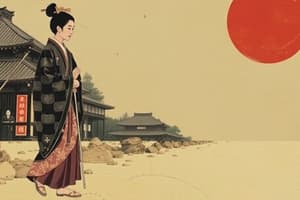Podcast
Questions and Answers
What is the time period of the Late Heian Period?
What is the time period of the Late Heian Period?
1086-1185
What is Shaka Nyorai known for?
What is Shaka Nyorai known for?
- Illustrated handscrolls
- Hanging scroll with color on silk (correct)
- Men's pictures
- Technique using cut gold (correct)
What is the kirikane technique used for?
What is the kirikane technique used for?
Cutting gold leaves to enhance paintings
What are Emakimono?
What are Emakimono?
What is tsukuri-e?
What is tsukuri-e?
What does onna-e depict?
What does onna-e depict?
What does otoko-e depict?
What does otoko-e depict?
Who is the main character in Genji Monogatari emaki?
Who is the main character in Genji Monogatari emaki?
Who authored the Genji Monogatari emaki?
Who authored the Genji Monogatari emaki?
What significant event does the Ceremony of Acknowledgement from the Kashiwagi chapter depict?
What significant event does the Ceremony of Acknowledgement from the Kashiwagi chapter depict?
What is depicted in the Genji meets dying lady Murasaki scene?
What is depicted in the Genji meets dying lady Murasaki scene?
What themes do the Shigisan Engi emaki suggest?
What themes do the Shigisan Engi emaki suggest?
What is the Chôjû Jinbutsu Giga known for?
What is the Chôjû Jinbutsu Giga known for?
What time period does the Ban Dainagon Ekotoba belong to?
What time period does the Ban Dainagon Ekotoba belong to?
What does the Nenjû Gyôji Emaki illustrate?
What does the Nenjû Gyôji Emaki illustrate?
Flashcards are hidden until you start studying
Study Notes
Late Heian Period (1086-1185)
- Era characterized by cultural development and artistic expression in Japan.
Shaka Nyorai
- Created between 1100 and 1185; hanging scroll made with color on silk.
- Utilizes kirikane technique (cut gold) for vibrancy and superhuman quality.
- Features a halo; flat design retains both naturalistic and abstract elements.
Kirikane
- A gold leaf technique used to enhance visual appeal in artwork.
Emakimono
- Illustrated handscrolls showcasing narratives through visual art.
Tsukuri-e
- Refers to "built-up" pictures, a method used in creating multi-layered images.
Onna-e
- Term for "women's pictures," focusing on feminine subjects and themes.
Otoko-e
- Refers to "men's pictures," emphasizing masculine aspects and themes.
Genji Monogatari emaki (Tale of Genji scroll)
- Created between 1100 and 1150; ink and color on paper.
- Narrative about the Heian court, authored by Murasaki Shikibu.
- Main character: Hikari Genji; known for its vibrant colors and sense of movement.
Hikari Genji
- Protagonist of the Tale of Genji, central to its emotional and narrative core.
Murasaki Shikibu
- Author of the Genji Monogatari; a prominent figure in the Heian court.
Ceremony of Acknowledgement (Kashiwagi chapter)
- Scene depicting Genji's complex emotions regarding a "son" he didn't father.
- Architectural elements reflect Genji's emotional discomfort.
Genji Meets Dying Lady Murasaki
- Scene from the Minori chapter portraying Genji's profound grief over Murasaki's illness.
Shigisan Engi emaki (Legend of Mount Shigi)
- Created between 1156 and 1180; features Myoren ordering a servant regarding a rice bale.
- Suggests themes of human weaknesses that must be overcome for Enlightenment.
Chôjû Jinbutsu Giga (Dancing Frogs)
- Created around 1150; depicts anthropomorphized frogs in a continuous narrative.
- Focuses on animals behaving like humans, illustrating a playful yet critical view of society.
Chôjû Jinbutsu Giga (Animals Watching Archery Contest)
- Further extension of the dancing frogs theme, featuring animals engaging in human-like activities.
Chôjû Jinbutsu Giga (Religious Service)
- Another segment of the Chôjû series highlighting animals in anthropomorphic roles within a religious context.
Ban Dainagon Ekotoba
- Created circa 1150-1185; ink and color on paper attributed to Tokiwa Mitsunaga.
- Represents important narratives and scenes from the Heian period.
Nenjû Gyôji Emaki (Scroll of Annual Events)
- From 1150; created by Tokiwa Mitsunaga in color on paper.
- Depicts the everyday life of aristocrats, showcasing their routines and seasonal activities.
Studying That Suits You
Use AI to generate personalized quizzes and flashcards to suit your learning preferences.




